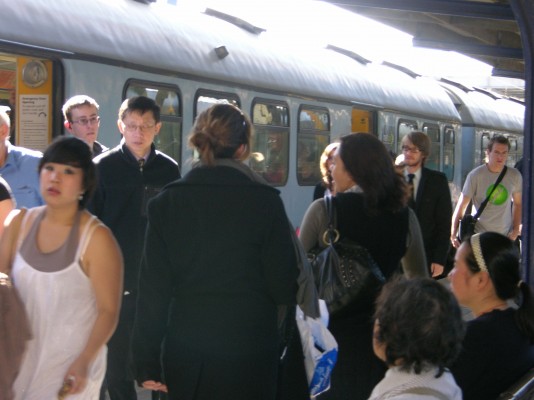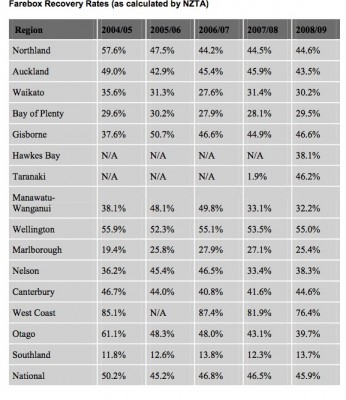Wgtn Fare Shock: Sign Of Future
Some Wellington public transport fares are set to double, in a sign of what’s ahead for Auckland with the new NZTA farebox recovery scheme.
- Inner city bus fares in both Wellington and Porirua CBDs will leap from $1 to $2
- 11-14 zone fares (which affect Wairarapa) will increase by $1 and $2
- Most single cash fares would increase by 50c
- The proposed October 1 fare rise would also coincide with and take into account the Government’s increase in GST
The proposal is being considered by the city’s regional council’s transport committee on Tuesday and the decision then goes to the full council.
The Committee noted that NZTA’s new required farebox recovery (the proportion of the costs of providing the service paid by the passenger) was within the target range set by Council (45-50%) but was forecast to fall below the target. NZTA wants a national farebox recovery ratio of no less than 50% in the medium term.
So it considered that a fare increase that generated extra revenue of 3% was required. Committee chair Peter Glensor says keeping that ratio “should help passengers avoid a very nasty shock in later years.”
But the council is signalling that because of the farebox scheme and the transport minister’s insistence passengers must pay their way more, a further increase will happen next year.
Next year’s increase will see an increase of multi-trip tickets rather than cash fares, which hardly encourages regular commuting by or switching to public transport.
This week’s ARC transport and urban development committee meeting saw officials saying they couldn’t or wouldn’t put any estimate yet on how much fares would go up as a result of the NZTA farebox recovery policy, which each regional coouncil has to have in place by January 1 2012.
So we have no idea yet what nasty shock Aucklanders are in for but the Wellington thinking confirms the only way is up. And Auckland’s current farebox ratio is 43.5% - less than Wellington’s so we have some way to go to get to 50%.
Also a close examination of Wellington’s proposed new fare schedule shows that it upsets the previous strict relativities between the cash fares and the multi-trip fares.
The ten-trip fare is now less than seven times the price of the cash fare.
The council’s transport official explains this by detailing the methodology in working out the increases with the GST increase coming in on the same day.
He says officials worked out the fare increases by starting with the ten-trip fare. The proposed increase was applied precisely to these fares (50 cent rounding is not applied to these fares as most of these tickets are purchased off-vehicle), and then the cash fare was increased (in all cases by 50 cents). The effect of this is that, for example, the four zone ten-trip concession fare will increase from $20 to $20.50, which is a 2.5% increase. The cash fare increases from $2.50 to $3.00.
“To do anything else would have resulted in a 20% increase in fares to cover the GST increase, and that was not considered appropriate. This increase should also have the desirable effect of encouraging passengers to use multi- trip tickets and smartcards (cash fares make up approximately 20% of all
fares).”
Wellington passengers using Snapper or multi-trip tickets would face a lesser increase for most zones than casual commuters. Multi-trip fares for 4-10 zone trips, for example, will increase by between 2.3 to 2.5%, i.e. only for the GST increase. Trips of between four and ten zones are undertaken largely by people travelling into Wellington from the Hutt Valley and Porirua / Kapiti.
Multi-trip fares for 11-14 zone trips (generally between Wellington and Wairarapa) would increase by between 8 and 14 percent.
The quarterly rail ticket has been abolished, special rail fares, particularly on the Johnsonville line, have been increased and the price of stadium special rail tickets has also been increased to make them more consistent with standard fares.
The council plans to keep the minimum fare scheme that applies on the Wairarapa trains for journeys between Wellington and Hutt Valley stations. The minimum cash fare is an eight zone fare ($9.50), and those using a Hutt Valley ten-trip ticket must pay a cash surcharge ($1 per trip on Upper Hutt tickets and $5 on Waterloo and Petone tickets).
This is only because Tranz Metro is reluctant to have a policy the application of which varies according to how full a train is. But the council is reviewing passenger numbers on the Wairarapa train after complaints about over-crowding.
* The latest farebox recovery levels (as calculated by NZTA) are shown in below. The levels show Wellington at 55.0% for 2008/09 (the highest in NZ, and up from 53.5% in 2008/09), with the national average 45.9% (down from 46.5%). The range is 13.7% to 55%1.













2 Comments
This farebox recovery scheme championed by this government is complete idiocy. Will rate payers notice the savings, No, just like we tax payers didn’t benefit when the governments of the day flogged off public assets. And add this rise to GST rise and every other tax rise this lot can think of.
Will some people stop using public transport, Yes, will fewer people using PT mean it will struggle even more to pay its way, Yes, will roads be a little more congested by cars using imported fuel, Yes. So short of wanting public transport to fail, why implement it??
Not impressed at the loss of the quarterly train pass and that the JVL line fares including Peace Train are being scrapped. Will make my $65 monthly go up to $90 in a short space of time. Understand the rationale though, zone 3 fares should be the same.
Remember also with Wellington that GW at the request of Tranz Metro has a policy of cash fares being eith x.00 or x.50 to make it easier on train staff.
Bring on smart card multi-mode integrated ticketing I say!